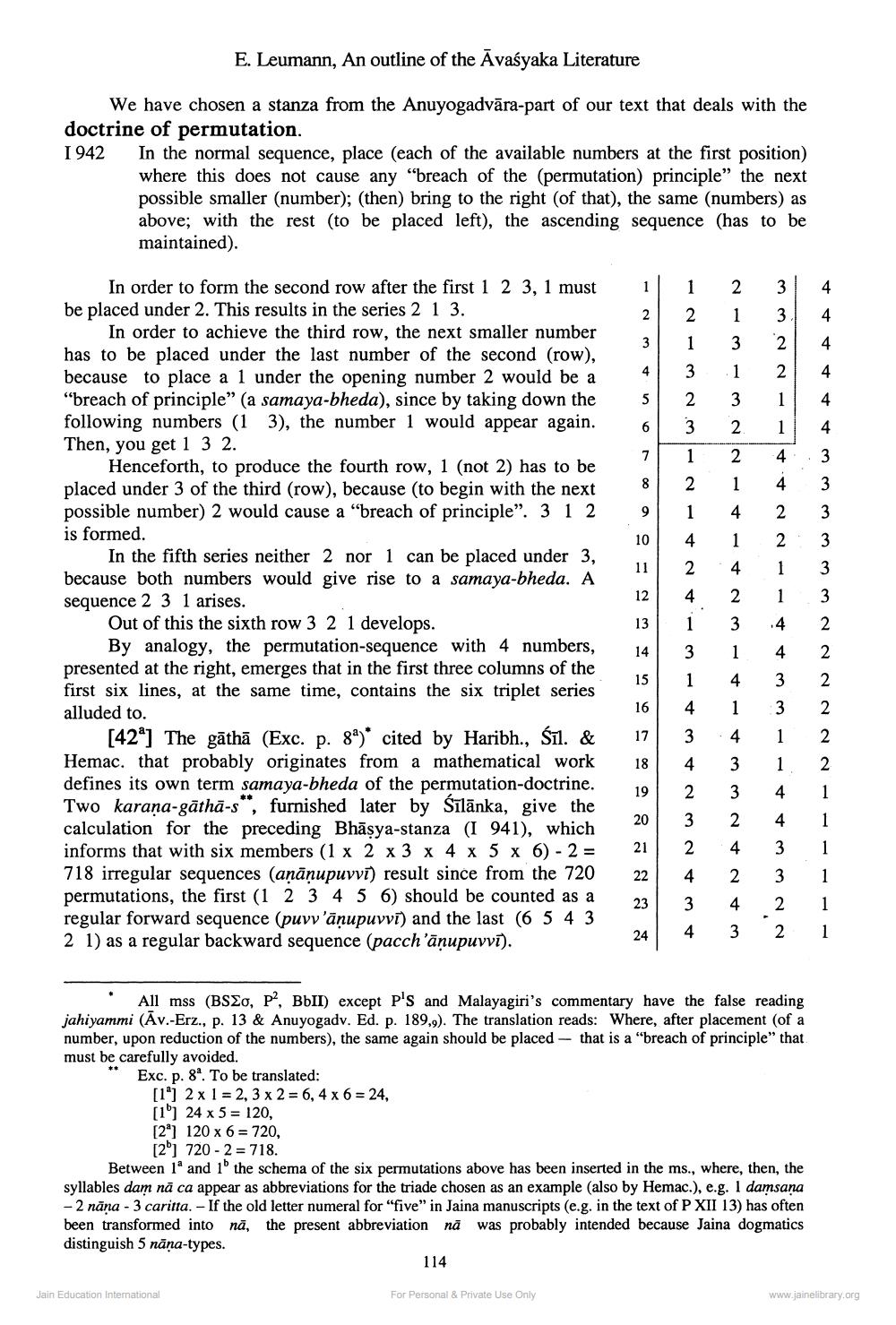________________
E. Leumann, An outline of the Āvaśyaka Literature
We have chosen a stanza from the Anuyogadvāra-part of our text that deals with the doctrine of permutation. I 942 In the normal sequence, place (each of the available numbers at the first position)
where this does not cause any "breach of the (permutation) principle" the next possible smaller (number); (then) bring to the right of that), the same (numbers) as above; with the rest (to be placed left), the ascending sequence (has to be maintained).
4 4
In order to form the second row after the first 1 2 3,1 must be placed under 2. This results in the series 2 1 3.
In order to achieve the third row, the next smaller number has to be placed under the last number of the second (row), because to place a 1 under the opening number 2 would be a "breach of principle” (a samaya-bheda), since by taking down the following numbers (1 3), the number 1 would appear again. Then, you get 1 3 2.
Henceforth, to produce the fourth row, 1 (not 2) has to be placed under 3 of the third (row), because (to begin with the next possible number) 2 would cause a "breach of principle". 3 1 2 is formed.
In the fifth series neither 2 nor 1 can be placed under 3, because both numbers would give rise to a samaya-bheda. A sequence 2 3 1 arises.
Out of this the sixth row 3 2 1 develops.
By analogy, the permutation-sequence with 4 numbers, presented at the right, emerges that in the first three columns of the first six lines, at the same time, contains the six triplet series alluded to.
[424] The gāthā (Exc. p. 89)* cited by Haribh., Śīl. & Hemac. that probably originates from a mathematical work defines its own term samaya-bheda of the permutation-doctrine. Two karana-gāthā-s", furnished later by Śīlānka, give the calculation for the preceding Bhāsya-stanza (1 941), which informs that with six members (1 x 2 x 3 x 4 x 5 x 6) - 2 = 718 irregular sequences (aņāņupuvvī) result since from the 720 permutations, the first (1 2 3 4 5 6) should be counted as a regular forward sequence (puvv'āņupuvvī) and the last (6 5 4 3 2 1) as a regular backward sequence (pacch'ānupuvvī).
1 1 2 3 2 2 1 3 3 1 3 2 4 3 1 2
2 3 11 6 3 2 1 71 2 4 8 2 1 4 9 1 4 2 10 4 1 2 11 2 4 1 12 4 2 1 13 1 3 4 14 3 1 4 15 1 4 3 16 4 1 3 17 3 4 1 18 4 3 1 19 2 3 4 20 3 2 4 21 2 4 3 22 4 2 3 23 3 4 2 24 4 3 2
3 3 3 3 2 2 2 2 2 2 1 1 1 1 1 1
* All mss (BSZO, P?, BbII) except P's and Malayagiri's commentary have the false reading jahiyammi (Av.-Erz., p. 13 & Anuyogadv. Ed. p. 189,9). The translation reads: Where, after placement (of a number, upon reduction of the numbers), the same again should be placed - that is a "breach of principle" that must be carefully avoided.
Exc. p. 89. To be translated:
[1] 2 x1 = 2, 3 x 2 = 6, 4 x 6 = 24, [10) 24 x 5 = 120, [2] 120 x 6 = 720,
[2] 720 - 2 = 718. Between 1 and 1 the schema of the six permutations above has been inserted in the ms., where, then, the syllables dam nā ca appear as abbreviations for the triade chosen as an example (also by Hemac.), e.g. 1 damsana - 2 nāna - 3 caritta. - If the old letter numeral for "five" in Jaina manuscripts (e.g. in the text of P XII 13) has often been transformed into nā, the present abbreviation na was probably intended because Jaina dogmatics distinguish 5 nāna-types.
114
Jain Education International
For Personal & Private Use Only
www.jainelibrary.org




